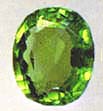Peridot

The name is derived from the Greek, but meaning is uncertain. Maybe it refers
to the numerous crystal planes of the crystal. Peridot was once referred to
as "chrysolite" (Greek - gold stone) as well as some other stones of similar color.
But the name commonly used in mineralogy is olivine due to its olive green color.
It has a vitreous and greasy luster, and is susceptible to Sulfuric acid. It
tends to be wrapped in metal foil due to its tendency to burst under great stress.
Rarities are peridot cat's eye and star peridot.
- Color : Yellow-green, olive green, brownish
- Color of streak : White
- Mohs' hardness : 6 1/2-7
- Specific gravity : 3.27-3.37
- Cleavage : Imperfect
- Fracture : Brittle, small conchoidal
- Crystal system : Orthorhombic; short, compact prisms, vertically striated
- Chemical composition : (Mg, Fe)2 SiO4 magnesium iron silicate
- Transparency : Transparent
- Refractive index : 1.654-1.690
- Double refraction : +0.036
- Dispersion : 0.020
- Pleochroism : Very weak; colorless to pale green, lively green, olive green
- Absorption spectrum : (6530), (5530), 5290, 4970, 4950, 4930,
4730, 4530
- Fluorescence : None
